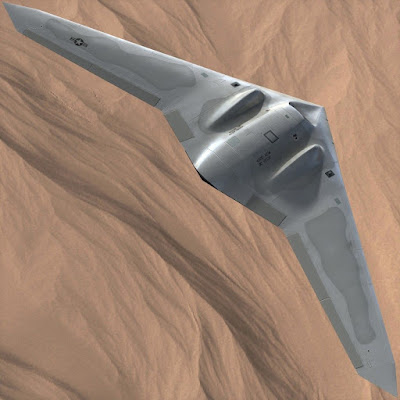ComNavOps has long stated that conventional UAVs are useless
in high end combat against a peer enemy because they’re not stealthy which
means they’re not survivable. Worse,
being non-stealthy, their operation will lead directly back to the controlling
unit’s location.
The lack of stealth means that they can’t be used for naval
recon and targeting because they’ll be spotted and destroyed long before they
can find the enemy. Some have claimed
that, being UAVs, they can fly at wave top height to avoid detection. This is true but it also means they can’t see
anything. If you want a useful field of
view (range), you have to operate at some significant altitude. If a non-stealthy UAV is at a significant
altitude, it will be spotted and destroyed before it can accomplish anything.
All of this changes, however, if the UAV is stealthy. Stealth, in this context, refers not just to
reduced radar signature but also to reduced infrared and visible
signatures.
Let’s briefly consider the known stealthy UAVs in the US
inventory. I’m only aware of two:
Let’s look at a few of their specifications in the following
table.
- RQ-170 Sentinel
- RQ-180 ?White Bat?
a The
RQ-180 specs are speculative with estimates putting the size in the RQ-4 Global
Hawk category so specifications have been adapted from that. Photos have fairly accurately determined the
wingspan and length.
Discussion
As we’ve discussed in the past, the vast majority of the
sensing capability would be passive (EO, IR, SigInt) in keeping with the stealth
and survivability requirements.
A small, stealthy UAV would give surface ships the ability
to establish situational awareness and conduct surveillance without
automatically giving away their own presence.
Consider what small, stealthy UAVS can do.
And, they can do this survivably with a reasonable chance of
not being detected. Isn’t that exactly
what we want in a naval surveillance asset?
The concept of operations (CONOPS) would be to continually
operate a dozen or more (work out the effective number in exercises) UAVs in
all directions while concentrating on the expected threat axis. As needed, a UAV could be sent on a one-way
mission which would double its range.
The major challenge in this concept is communications and I
simply don’t know enough to offer a solution.
Satellite communications are an option if we have sufficient surviving
satellites. High altitude communications
relay aircraft using line-of-sight is another option. As I said, I just don’t know. Communications experts would have to work
that out.
Larger UAVs, on the order of the RQ-170, can be operated
from dedicated UAV carriers and thought should be given to routinely
integrating a UAV carrier with every surface group.
- They can extend the situational awareness out to 200+ miles.
- They can act as early warning detectors of attacking aircraft and missiles.
- They can act as fire control spotters for naval guns and missiles.
- They can provide targeting for anti-ship missiles.



How fast do you think they need to be? If you can accept car highway speed then I think you could have an even smaller and cheaper class of scout drones, which also makes them easier to "stealth." They'd essentially be powered gliders.
ReplyDelete"How fast do you think they need to be?"
DeleteMaybe 100 mph? That would get them on station (200 miles out) in two hours. That seems reasonable.
The best UAV candidate for such specifications is Iranian Shahed 136. More details https://mil.in.ua/en/news/the-way-the-russians-launch-shahed-drones-was-revealed/
ReplyDeleteThose drones are far from stealth. They are incredibly loud and have very visible IR signatures. I'm not sure about radar cross section but the open engine/propeller would suggest it's not invisible. A stealth drone would probably need a ducted fan with a much more quiet and efficient engine that isn't throwing heat and sound everywhere.
DeleteThose Shaheds exist in 2 variants: jet engine (the last one) which is visible in IR signature and propeller variant which is loud when it flies high (tens-hundreds of meters above the ground). CNO assumes the UAV should be able to fly at high altitudes. Sure he means at least 5-6 km above the sea. On the such altitudes no one can hear the noise of propeller engine. The radar cross section is very very low. Once I read on the Ukrainian sources. They claimed that Shahed RCS is about 0.05-0.01 meters square.
DeleteThere is too little heat from the Shahed. It is not easy to shoot it down using FIM-92 Stinger. Much harder than helicopter.
A human ear may not be able to hear it, but many microphones could, especially if they have directional designs. The Ukrainians were able to put together a very wide area listening network on short notice, many countries would be capable of doing that.
DeleteBeing visible on an IR scope is a much lower threshold than being a large enough target for a missile that is decades old and designed for targets with 20x-100x bigger engines. And the IR scope is the one that matters, not the stinger missile seeker.
"UAV should be able to fly at high altitudes. ... at least 5-6 km above the sea."
DeleteYes, higher altitudes are necessary to obtain a useful field of view and range of view. Whether that's on the order of 5000 ft or 20000 ft or, perhaps, a porpoising flight profile, is something that exercises would have to work out (develop a concept of operations).
Successful detection of an enemy ship would occur, ideally, at ranges on the order of 20+ miles so noise is probably not an issue. IR would likely be of more concern.
"The Ukrainians were able to put together a very wide area listening network on short notice"
Of course, we're talking about maritime applications rather land.